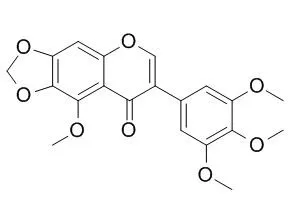| In vitro: |
| Biomedicine (Taipei). 2015;5(1):4. Epub 2015 Feb 2. | | Irisflorentin improves α-synuclein accumulation and attenuates 6-OHDA-induced dopaminergic neuron degeneration, implication for Parkinson's disease therapy.[Pubmed: 25705584] | Parkinson's disease (PD) is a degenerative disorder of the central nervous system that is characterized by progressive loss of dopaminergic neurons in the substantia nigra pars compacta as well as motor impairment. Aggregation of α-synuclein in neuronal cells plays a key role in this disease. At present, therapeutics for PD provides moderate symptomatic benefits, but it is not able to delay the development of the disease.
Current efforts toward the treatment of PD are to identify new drugs that slow or arrest the progressive course of PD by interfering with a disease-specific pathogenetic process in PD patients. Irisflorentin derived from the roots of Belamcanda chinensis (L.) DC. is an herb which has been used for the treatment of inflammatory disorders in traditional Chinese medicine.
METHODS AND RESULTS:
The purpose of the present study was to assess the potential for Irisflorentin to ameliorate PD in Caenorhabditis elegans models. Our data reveal that Irisflorentin prevents α-synuclein accumulation in the transgenic Caenorhabditis elegans model and also improves dopaminergic neuron degeneration, food-sensing behavior, and life-span in a 6-hydroxydopamine-induced Caenorhabditis elegans model, thus indicating its potential as a anti-parkinsonian drug candidate. Irisflorentin may exert its effects by promoting rpn-3 expression to enhance the activity of proteasomes and down-regulating egl-1 expression to block apoptosis pathways.
CONCLUSIONS:
These findings encourage further investigation on Irisflorentin as a possible potent agent for PD treatment. | | Cell Transplant. 2015;24(3):573-88. | | Irisflorentin modifies properties of mouse bone marrow-derived dendritic cells and reduces the allergic contact hypersensitivity responses.[Pubmed: 25654487] | Irisflorentin is an isoflavone component derived from the roots of Belamcanda chinensis (L.) DC. In traditional Chinese medicine, this herb has pharmacological properties to treat inflammatory disorders. Dendritic cells (DCs) are crucial modulators for the development of optimal T-cell immunity and maintenance of tolerance. Aberrant activation of DCs can induce harmful immune responses, and so agents that effectively improve DC properties have great clinical value.
METHODS AND RESULTS:
We herein investigated the effects of Irisflorentin on lipopolysaccharide (LPS)-stimulated maturation of mouse bone marrow-derived DCs in vitro and in the contact hypersensitivity response (CHSR) in vivo. Our results demonstrated that treatment with up to 40 μM Irisflorentin does not cause cellular toxicity. Irisflorentin significantly lessened the proinflammatory cytokine production (tumor necrosis factor-α, interleukin-6, and interleukin-12p70) by LPS-stimulated DCs. Irisflorentin also inhibited the expression of LPS-induced major histocompatibility complex class II and costimulatory molecules (CD40 and CD86) on LPS-stimulated DCs. In addition, Irisflorentin diminished LPS-stimulated DC-elicited allogeneic T-cell proliferation. Furthermore, Irisflorentin significantly interfered with LPS-induced activation of IκB kinase, c-Jun N-terminal kinase, and p38, as well as the nuclear translocation of NF-κB p65. Subsequently, treatment with Irisflorentin obviously weakened 2,4-dinitro-1-fluorobenzene-induced delayed-type hypersensitivity.
CONCLUSIONS:
These findings suggest new insights into the role of Irisflorentin as an immunotherapeutic adjuvant through its capability to modulate the properties of DCs. |
|






 Cell. 2018 Jan 11;172(1-2):249-261.e12. doi: 10.1016/j.cell.2017.12.019.IF=36.216(2019)
Cell. 2018 Jan 11;172(1-2):249-261.e12. doi: 10.1016/j.cell.2017.12.019.IF=36.216(2019) Cell Metab. 2020 Mar 3;31(3):534-548.e5. doi: 10.1016/j.cmet.2020.01.002.IF=22.415(2019)
Cell Metab. 2020 Mar 3;31(3):534-548.e5. doi: 10.1016/j.cmet.2020.01.002.IF=22.415(2019) Mol Cell. 2017 Nov 16;68(4):673-685.e6. doi: 10.1016/j.molcel.2017.10.022.IF=14.548(2019)
Mol Cell. 2017 Nov 16;68(4):673-685.e6. doi: 10.1016/j.molcel.2017.10.022.IF=14.548(2019)